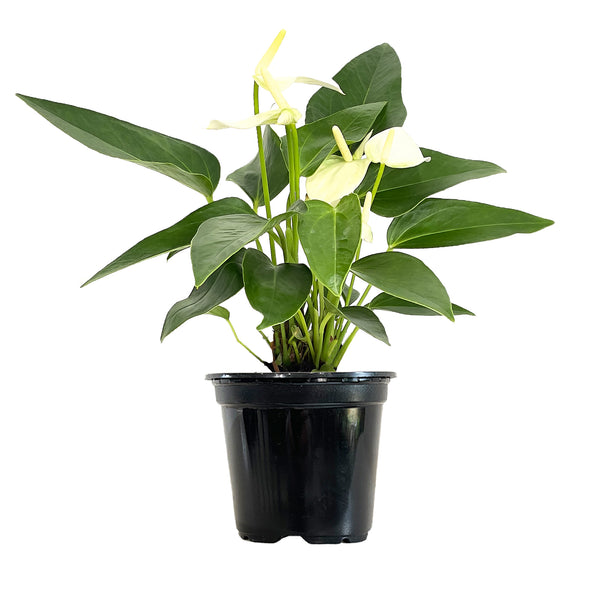A Beginner’s Plant Care Guide for Anthurium
Family: Araceae
Common Name: Flamingo Flower, Tail Flower, Painted Tongue Plant, Bird’s Nest Anthurium, Water Dragon Anthurium, Bird’s Nest Anthurium
Botanical Name: Anthurium andraeanum, Anthurium fruffles, Anthurium plowmanii

Psst..Here’s a little secret: the beautiful heart-shaped “flowers” are not flowers! Tell Everyone! What makes these durable, easy-care houseplants so appealing are red, white, pink, or purple waxy leaves called spathes that flare from the base of the fleshy spike where the actual tiny flowers grow. Now that you know that you are almost an expert!
These indoor plants are epiphytes, a type of air plant that comes from warm, tropical regions where they either grow on the surface of other plants and can actually grow in rich organic humus. Therefore, as a houseplant, the anthurium is extremely durable and requires little care. Simply re-pot with a peat moss or a coco coir-based soil mixture, provide bright, indirect sunlight, and allow the soil to partially dry out between watering. For more robust, repeated “flowering,” allow your anthurium to rest for six weeks with little water during the winter at approximately 60°F. If you notice that the “flower” is green rather than the color you were expecting, it may be a new sprout that was forced to bloom when it should have been resting. If a “flower” is fading, it is likely an older bloom that is ready to dry up and fall off (see below for care).
Not all anthurium are coveted for their “blooms” (we apologize for the quotes at this point and you most likely get the point). Anthurium that are admired for their foliage have similar care requirements as the “flowering” kinds (we did it again). but the only difference is that they do not need as much light. Varieties like Anthurium superbum, Water Dragon, plowmanii, and Jungle Bush can tolerate lower light!
Important! Anthurium is poisonous if ingested, so be very careful if you have pets and/or small children. The sap can also cause skin irritation.

Light
Flowering Anthurium needs bright, indirect light (direct sunlight will scorch the leaves and flowers!). Low light will slow growth, dull the color, and produce fewer, smaller “flowers.” Place your anthuriums in a setting where they will receive at least 6 hours of bright indirect sunlight each day.
Water
Water thoroughly when the few inches of the soil becomes dry to the touch, stopping when water starts draining from the drainage holes. Avoid over-watering (Anthurium roots are susceptible to rot!). The more light and warmth that your anthurium gets, the more water it will need, so check the soil for dryness every few days. These plants will provide signs of stress or thirst, so pay attention: thirsty plants will be light if you lift them and will have droopy or puckering leaves. You will not need to water as often in the winter when the plant is not actively growing.
Soil
Anthurium are epiphytes, meaning they do not necessarily need soil to grow! They use the moisture from the air and nutrients from their host (usually a tree or surrounding dead plant material. Their potting soil should contain more drainage materials (compared to soils for most indoor plants), such as wood chips, perlite, coarse sand, or pumice, to allow the water to drain quickly.
Most bagged soil-less potting soil made for indoor plants will work fine but remember that you must let the soil dry out completely before watering it again. You can add cactus potting soil mix to your potting soil to help the water drain if you feel the roots are staying wet for too long! A great time to do this is when you need to re-pot your anthurium into a larger pot.
Temperature
Anthuriums prefers very warm temperatures (70-90°F), but don’t worry – these plants are extremely adaptable and can flourish in typical household temperature ranges. However, be careful of temperature extremes: if your thermostat drops below 50°F, the anthurium will stop growing; if your house gets too hot, your anthuriums will wilt.
Humidity
Most anthuriums thrive on humidity, but the flowering varieties can tolerate more dryness. If your humidity level is less than 50%, then consider using a humidifier to increase the level to at least 60%. Filling small trays with pebbles and water and grouping indoor plants together can slightly increase the humidity immediately surrounding your plants. Learn how to increase the humidity for your indoor plants!
Fertilizer
During the growing season (spring and summer), feed your anthurium once a month using a complete, ¼-strength liquid fertilizer. Note — too much fertilizer can do more harm than good. To encourage more blooms, use a fertilizer higher in phosphorus during the growing season.
Growth Rate
Anthurium are slow-growing indoor plants, averaging around 4″ per year! The leaves will become larger if cared for properly, but the plant itself will not exceed heights over 30″.
Pet Friend or Foe
All anthurium are toxic to pets! Foe!
Pro Tips
- Use a fertilizer high in phosphorus to promote blooms in flowering varieties.
- Use soil that drains well to avoid root rot, but holds enough moisture for root absorption.
- Don’t be alarmed when you see roots growing from the stems! These are simply aerial roots that would benefit from occasional misting. If you don’t like the look of these roots, you can cut them without hurting the plant.
- As your anthurium grows, place it in a bigger pot. Crowded roots will stunt the plant’s growth!
- When the flowers fade and you want to remove them, cut at the base of the flower stem, closest to the base of the plant.

